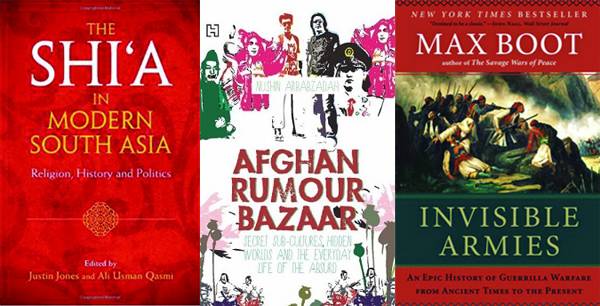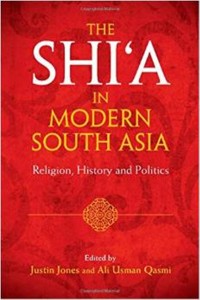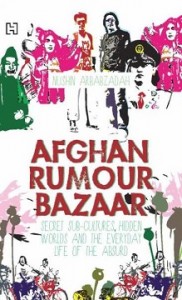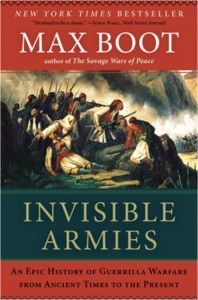
The Shi’a in Modern South Asia: Religion, History and Politics

Ed. Justin Jones and Ali Usman Qasmi
Cambridge University Press [paperback], 2015
PRs 1,195
The Shi’i communities of South Asia, roughly 60 million people, represent, after those of Iran, the second largest grouping of Shi’as in the Muslim world. Until recently, our knowledge of them has not matched their numbers. Indeed, they have suffered from the paradox of being both highly visible but in scholarly terms largely invisible. Where the Shi‘a live in South Asian towns and cities, arguably, no community has been more visible or more audible: visible because of their great processions at Muharram and audible – certainly at Muharram, but also throughout the year in their majalis – as they recount the events of Karbala.
The essays in this volume illustrate how scholars are beginning to develop a grasp of religious change among the Shi’as over the past two centuries to match that which has been achieved for the Sunnis. The following themes, all present to a greater or lesser extent in modern scholarship on the Shi‘a of South Asia, run through these essays: there is the role of political power, but also its lack, in establishing and shaping Shi‘i communities. There is the centrality of the tragedy of Karbala to Shi‘i identity and to the Shi‘i sense of community. There is the tendency, as time moves towards the present, for Shi‘i practices of pluralism and inclusiveness to weaken in favour of exclusiveness. Associated with this development, there is the impact of religious reform and significant religious change, which compares suggestively with religious change in the Sunni world. There is the enduring impact of Iran, the Shi‘i centres in Iraq and, more recently, Shi‘i activism in the Lebanon. Finally, there is the specific role of women in fashioning Shi‘i devotion and community. The contributions to this volume add to the understanding of power and the shaping of Shi‘i communities.
Afghan Rumour Bazaar: Secret Sub-Cultures,
Hidden Worlds and the Everyday Life of the Absurd

Nushin Arbabzadah
Hurst [hardback], 2013
PRs 3,010
Ironic and humorous, witty and self-deprecatory, Afghan Rumour Bazaar reveals the quotidian absurdities of lives framed against the backdrop of a savage war. Offering daringly new perspectives on a country that readers may erroneously assume they know, Nushin Arbabzadah delves into the unacknowledged (but real) secret sub-cultures and hidden worlds of Afghans, from underground converts to Christianity to mysterious male cross-dressers to tales of bacha-posh girl-boys.
Among the individuals, fables and dilemmas she confronts are “Why are Imams Telling Us About Nail Polish?”, “Afghanistan’s Rich Jewish Heritage”, “Kabul Street Style”, “The Resurgence of Afghanistan’s Spiritual Bazaar”, and not forgetting Malalai of Maiwand, who turned her headscarf into a banner and led a successful rebellion against the British.
Arbabzadah reveals for the first time the Afghans’ own vibrant internal deliberations – on sex and soap operas, conspiracy theories, drugs and diplomacy, terrorism and the Taliban, and how a long-dead soothsayer from Bulgaria accidentally shut down a newspaper. Many different Afghan sensibilities are presented in her book, yet together they offer an unvarnished, at times heart-warming, at times tragic, insight into one of the most complex and fascinating countries on earth.
What people are saying: “A wry and witty narrative that’s authoritative, affectionate, and at moments wonderfully absurd” (Lyse Doucet, Chief International Correspondent, BBC).
“Part memoir, part journalism and part storytelling, the book is a heady ride into the craziness that is Afghan life” (Jyotsna Nambiar, PostNoon).
Invisible Armies: An Epic History of Guerrilla Warfare from Ancient Times to the Present

Max Boot
Liveright [paperback], 2013
PRs 2,280
Invisible Armies presents an entirely original narrative of warfare, which demonstrates that, far from the exception, loosely organized partisan or guerrilla warfare has been the dominant form of military conflict throughout history. New York Times best-selling author and military historian Max Boot traces guerrilla warfare and terrorism from antiquity to the present, narrating nearly 30 centuries of unconventional military conflicts. Filled with dramatic analyses of strategy and tactics, as well as many memorable characters – from Italian nationalist Guiseppe Garibaldi to the “Quiet American,” Edward Lansdale – Invisible Armies is “as readable as a novel” (Michael Korda, Daily Beast) and “a timely reminder to politicians and generals of the hard-earned lessons of history” (Economist).
Poets’ corner
No more…
I have no more blood to spill.
My veins are dry, but still
My heart beats, pumping clots of remonstrance.
I have no more tears to shed.
My eyes are no longer red,
Instead ringed Saturns of grief and shame.
I have no other life to live,
No sacrifice left to give
To propitiate that Satan of a single bullet.
I have no words left to say
A farewell to myself the day
Death, like Edhi’s van, shall come for me.
F. S. Aijazuddin

